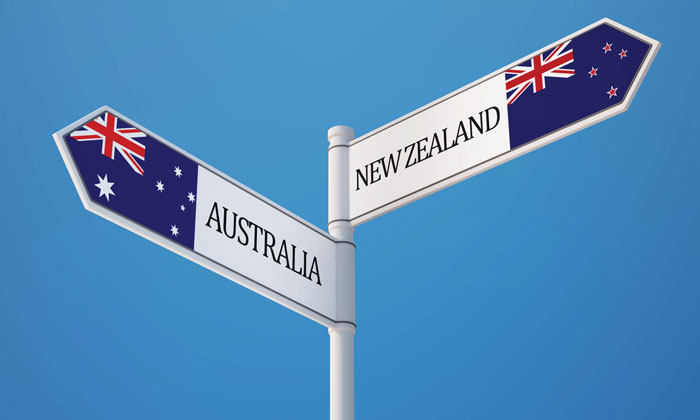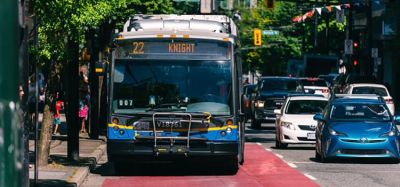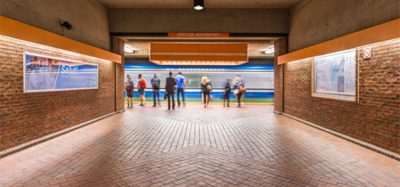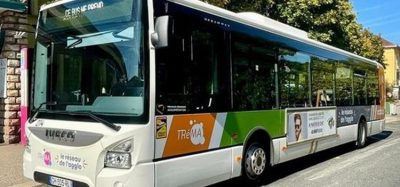On the right track: the future of Australian and New Zealand transport infrastructure
- Like
- Digg
- Del
- Tumblr
- VKontakte
- Buffer
- Love This
- Odnoklassniki
- Meneame
- Blogger
- Amazon
- Yahoo Mail
- Gmail
- AOL
- Newsvine
- HackerNews
- Evernote
- MySpace
- Mail.ru
- Viadeo
- Line
- Comments
- Yummly
- SMS
- Viber
- Telegram
- Subscribe
- Skype
- Facebook Messenger
- Kakao
- LiveJournal
- Yammer
- Edgar
- Fintel
- Mix
- Instapaper
- Copy Link
Posted: 19 October 2016 | Yasha Vojdani, Interim Executive Director & Angé Anczewska, Manager of Development and Engagement at UITP Australia New Zealand (UITPANZ), | No comments yet
By 2050 70% of the world’s population is expected to live in urban environments – up from an average of 50% today. Australia and New Zealand are ahead of the curve in this respect, with close to 90% of the population currently living in urbanised areas. For Intelligent Transport, Yasha Vojdani, Interim Executive Director and Angé Anczewska, Manager of Development and Engagement at UITP Australia New Zealand (UITPANZ), provide details of current major public transport infrastructure projects across the region. These investments demonstrate commitment by Federal, State and Local governments to developing urban infrastructure for a growing and highly urbanised population, and highlight that effective public transport infrastructure networks are vital for the future growth, efficiency and productivity of cities.


Unlike other major cities around the world, Australia and New Zealand have the luxury of space and, as such, our cities have tended to develop over larger geographies, resulting in lower population densities. This type of topography creates challenges for public transport planning and delivery as less-efficient transport outcomes are typically achieved when compared with higher density geographies. For example, as a population we are highly reliant on our cars and, on average, our urban population will only take one public transport trip for every 10 urban private car trips.
The urban landscape in Australia and New Zealand is changing
With high levels of population growth focussed on our metropolitan and urbanised areas, the public transport and road networks are starting to reach and, in some cases, exceed capacity during peak periods. Infrastructure Australia – the Federal Government’s independent infrastructure advisory body – has estimated that the economic cost of congestion in Australian cities will increase three-fold over the next 15 years.
An effective public transport infrastructure network is crucial to ensure that our cities are fit for growth and that the efficiency and productivity of our cities are maintained.
Federal, State and Local Governments have all stepped-up to the challenge. To ensure our cities retain their statuses of being some of ‘the best places in the world to live’, significant investments in urban transport infrastructure have been committed that are focussed on growing transport networks and improving existing levels of service and quality.
ANZ is currently experiencing a once-in-a-generation transformation across its cities with respect to transport infrastructure. Roads are being ripped up to pave the way for light-rail projects across the country; huge tunnel-boring machines are churning through the Earth’s crust to create brand new subterranean transport routes; and transport fleets and rolling stock are also being expanded and modernised. In addition, government agencies are embracing new technologies and innovations in this sector.
With a strong and growing pipeline of projects in the planning phase, this is, by no means, the final stop in our journey.
To follow, in this article, are just a few of many examples of how we are transforming the public transport infrastructure across the region.
Major rail projects
Sydney Metro
Sydney Metro1 is one of Australia’s largest public transport projects. This new standalone railway will deliver 31 metro stations and more than 65km of new metro rail. Expected project costs are $12 billion and the first stage of Sydney Metro will deliver the first fully-automated metro rail system in Australia. Sydney Metro City & Southwest is the second stage.
Sydney Metro Northwest is delivering eight new railway stations and 4,000 commuter car parking spaces to Sydney’s growing North West. Trains will run every four minutes in the peak – that’s 15 trains an hour.
Melbourne Metro Tunnel
The Melbourne Metro Tunnel2 is one of the largest public transport projects ever undertaken in Australia and the first major investment in Melbourne’s CBD rail capacity since the City Loop was completed 30 years ago. The project has a value of $10.9 billion and will create a new end-to-end rail line from Sunbury in the west to Cranbourne/ Pakenham in the south-east, with high capacity metropolitan trains and five new underground stations.
The Metro Tunnel will comprise twin 9km-long rail tunnels connecting the Sunbury and Cranbourne/Pakenham lines. In addition there will be five new underground stations at Arden, Parkville, CBD North, CBD South and Domain with longer platforms to accommodate High Capacity Metro Trains (HCMTs) and high capacity signalling.
Brisbane Cross River Rail
Cross River Rail3 is the Queensland Government’s highest priority infrastructure project and an important part of our vision to cater for future growth, unlock economic opportunities and make Queensland a more internationally competitive state.
A 10.2km-long link from Dutton Park to Bowen Hills – with 5.9km of tunnel under the Brisbane River and CBD – Cross River Rail will connect to both northern and southern rail networks from day one of operations, providing significant benefits to commuters from both directions. This second rail river crossing will ease congestion, improve network reliability and increase accessibility to the Brisbane CBD, allowing more people to travel longer distances, with shorter journey times.
Queensland Moreton Bay Rail Link
Moreton Bay Rail Link4 will deliver a 12.6km dual-track passenger rail line between Petrie and Kippa-Ring, including six new rail stations at Kallangur, Murrumba Downs, Mango Hill, Kinsellas Road, Rothwell and Kippa-Ring.
The Moreton Bay Rail Link will provide a focal point for the local community and will include a number of features including 22 bridge structures, new rail stations, 3,000 car parks, stabling and train crew facilities and a 3m-wide shared path for cyclists and pedestrians across the entire route.
Perth City Link
Perth City Link5 is a collaborative project funded by three tiers of government and led by the Metropolitan Redevelopment Authority (MRA) and the Public Transport Authority (PTA). The transport project is being delivered in two stages: Rail (2011-2013) and Bus (2014-2016).
The project area is a live operating rail environment. Works are being scheduled to minimise disruption to train services and to people moving in and around the project area. The rail project area is 1.2km-long. Sinking the two remaining (Fremantle Railway) lines between the Horseshoe Bridge and Milligan Street, in conjunction with construction of a new underground Wellington Street Bus Station, will connect Perth’s Northbridge District with its main city retail and business area. It will also enhance the vitality of the area by optimising integration of the busiest public transport HUB within the metropolitan area and its surroundings.
Perth Forrestfield-Airport Link
Forrestfield-Airport Link6 is a new train line that will connect Forrestfield to the city, opening up Perth’s eastern suburbs to the rail network for the first time. The rail link will connect with the existing Midland line near Bayswater Station and will run to Forrestfield through underground tunnels to ensure minimal impact on the existing land and road network.
Auckland City Rail Link
The City Rail Link7 is a rail project that consists of an electrified, doubletrack rail tunnel underneath Auckland’s city centre, running for approximately 3.5km between Britomart Transport Centre and the Western Line, connecting just west of Mount Eden Railway Station. Two underground stations will be provided in Auckland’s CBD: Aotea Station (located near Aotea Square) and Karangahape Station (located in the vicinity of Karangahape Road).
In September 2016 the government formally confirmed its intention to fund its proposed share of 50% of the City Rail Link. The cost of the City Rail Link was then re-estimated to be between $2.8 and $3.4 billion, subject to tenders for remaining contracts.
Major light-rail projects
Sydney CBE and South East Light Rail
The CBD and South East Light Rail8 will be running from Circular Quay at the northern end of the Central Business District to the south-eastern suburbs of Randwick and Kingsford. The line will be part of Sydney’s light-rail network. Major construction commenced in October 2015 and the project is managed by Transport for NSW, a statutory authority of the New South Wales Government. Construction, operation and maintenance of the line are contracted to the ALTRAC Light Rail consortium.
Transport for NSW is investigating an extension along the southern Anzac Parade corridor. Three potential options are being examined: a 1.9km-long extension to Maroubra Junction; a 5.1km-long extension to Malabar; and a 8.2km-long extension to La Perouse.
Canberra Light Rail9
With operations to commence in 2019, light-rail will run from City to Gungahlin, along Northbourne Avenue and Flemington Road, delivering high quality, reliable and frequent public transport along one of Canberra’s busiest corridors. The 12km-long route will offer six-minute peak service (10-15 minute off peak), 13 stops, and 14 light-rail vehicles with a capacity of more than 200 people.
Gold Coast Light Rail (Stage 2)
The 13km-long Gold Coast Light Rail opened in July 2014. Gold Coast Light Rail (Stage 2)10 will connect the existing light-rail system at Southport to heavy-rail at Helensvale Station. The 7.3km-long route runs from Helensvale heavy-rail station adjacent to the Gold Coast Line, then adjacent to the Smith Street Motorway to connect with Stage 1 at the Gold Coast University Hospital light-rail station.
The alignment uses existing road and rail corridors, therefore reducing impacts on the community and the environment. The reference design includes three new stations at Helensvale, Parkwood and Parkwood East. It also includes a new 1,000 space car Park ‘n’ Ride facility at Parkwood Station and a 400 space expansion of the existing Park ‘n’ Ride facility at Helensvale Station.
Major bus and ferry projects
Sydney Northern Beaches B-Line
The NSW Government is delivering a programme of service and infrastructure improvements to deliver a new B-Line11 bus service. The new service is scheduled to start operating in late-2017. The B-Line will provide more frequent and reliable services for customers travelling between the Northern Beaches and the Sydney CBD.
B-Line services will run every five minutes in the busy morning and afternoon peak commute periods, and every 10 minutes at other times of the day, including weekends. The B-Line service will run until 12.30am every day, with services every 10 minutes in the evenings up to 11pm.
Sydney Ferry modernisation
The first stage of upgrading the Sydney Ferries’ fleet12 is an investment in six new ferries, with the first vessel due to be on the water in late- 2016. The rest will be delivered progressively throughout 2017. Following an open tender process that attracted international bids, Australian shipbuilder, Incat Tasmania Pty Ltd, has been awarded the contract to prepare detailed designs and build the new ferries. Incat is based in Hobart and renowned internationally for high quality environmentally-friendly and efficient vessels.
Melbourne SmartBus
A network of premium SmartBus13 routes operates across Melbourne. The SmartBus network includes three orbital SmartBus routes and four Doncaster Area Rapid Transit SmartBus routes that run from Manningham to the City.
SmartBus has been designed to complement Melbourne’s radial train and tram network by providing ‘cross-town’ connections to train stations, tram lines, schools, universities, hospitals and shopping centres. Services run along major arterial roads, making journey times shorter and journeys more direct for passengers.
References
- www.sydneymetro.info
- www.metrotunnel.vic.gov.au
- www.crossriverrail.qld.gov.au
- www.tmr.qld.gov.au/moretonbayrail
- www.mra.wa.gov.au/projects-and-places/perth-city-link
- www.forrestfieldairportlink.wa.gov.au
- www.at.govt.nz/projects-roadworks/city-rail-link
- www.sydneylightrail.transport.nsw.gov.au
- www.transport.act.gov.au/light-rail-project
- www.gclrstage2.com.au/stage2
- www.b-line.transport.nsw.gov.au
- www.transport.nsw.gov.au/projects-sydneys-ferry-fleet
- www.ptv.vic.gov.au/projects/buses/smartbus
Biography


Yasha Vojdani leads the UITP’s activities in Australia and New Zealand. Prior to joining UITP he was a transport sector consultant and has experience working across European and Australasian transport markets.


Angé Anczewska is a trained lawyer and is responsible for managing engagement with UITP members in the ANZ region. Prior to UITP she worked at the Australasian Railway Association.
Related topics
Business Models, Infrastructure & Urban Planning, Multimodality
Issue
Issue 5 2016
Related cities
Australia, New Zealand
Related organisations
UITP Australia New Zealand (UITPANZ)
Related people
Angé Anczewska, Yasha Vojdani








